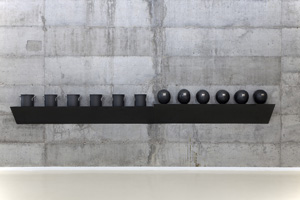Since the late 1970s and early 1980s Haim Steinbach has been arranging, upon his handmade shelves, various groups of everyday objects – usually unused objects and commodities manufactured on mass production lines: cornflakes packages, pots, shoes, toys, garbage cans, toilet brushes, and many more. The shelves themselves are in the form of inverted triangles, whose bases constitute the surface on which the objects are placed. The non-hierarchical, yet calculated, appearance of these objects upon the shelves can be read as a display of that which has remained. The moment of display is the concluding moment of their journey. The appearance of the objects on the shelves may indicate their disappearance from the mundane world, the cycle of life out of which they were taken, thus charging Steinbach’s systematic exhibitory action with qualities of redemption. Steinbach’s action does not follow the simple factuality of tracing or tracking; yet the display over the shelves can turn out to be an act of commemoration, which attributes to the objects aspects of potential findings, potential (untouched) relics. To the redemptory dimension of Steinbach’s action, however, one must add a contrary but complementary dimension. The possibility of experiencing their disappearance from the real world in the appearance of the objects upon the shelves makes Steinbach’s action destructive as well. It may not only denote disappearance, but make things disappear itself, so that the transition Steinbach performs from the world to the space of art turns into an act of subtraction. By means of alienation and the removal of things from their context, far from the discourse of the assemblage and without any pretension to the transformation or transcendence of the commonplace object, Steinbach’s work creates a competitive, and perhaps destructive, relation between itself and the world.
Less Reading...
